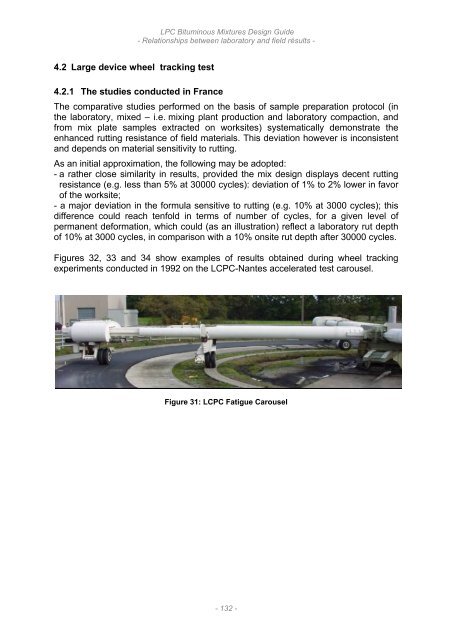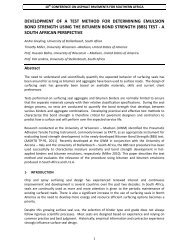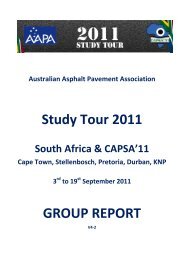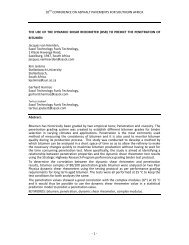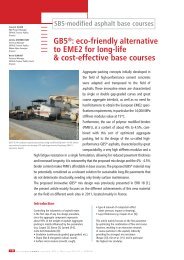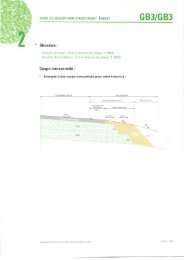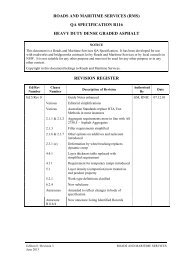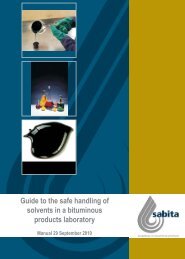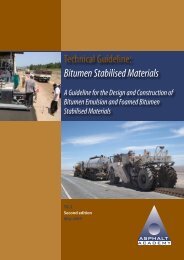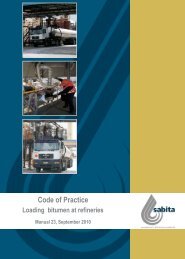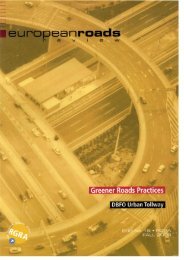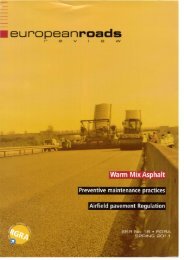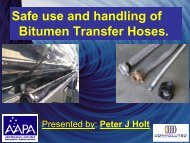- Page 1 and 2:
LPC Bituminous Mixtures Design Guid
- Page 3 and 4:
LPC Bituminous Mixtures Design Guid
- Page 5 and 6:
LPC Bituminous Mixtures Design Guid
- Page 7 and 8:
Table of ContentsPREFACE ..........
- Page 9 and 10:
3.4.4 Discontinuity ...............
- Page 11 and 12:
Table of illustrationsFigure 1: Gyr
- Page 13 and 14:
Table 40 - Adjustment to average te
- Page 15:
LPC Bituminous Mixtures Design Guid
- Page 18 and 19:
LPC Bituminous Mixtures Design Guid
- Page 20 and 21:
LPC Bituminous Mixtures Design Guid
- Page 22 and 23:
LPC Bituminous Mixtures Design Guid
- Page 24 and 25:
LPC Bituminous Mixtures Design Guid
- Page 26 and 27:
LPC Bituminous Mixtures Design Guid
- Page 28 and 29:
LPC Bituminous Mixtures Design Guid
- Page 30 and 31:
LPC Bituminous Mixtures Design Guid
- Page 32 and 33:
LPC Bituminous Mixtures Design Guid
- Page 34 and 35:
LPC Bituminous Mixtures Design Guid
- Page 36 and 37:
LPC Bituminous Mixtures Design Guid
- Page 38 and 39:
LPC Bituminous Mixtures Design Guid
- Page 40 and 41:
LPC Bituminous Mixtures Design Guid
- Page 42 and 43:
LPC Bituminous Mixtures Design Guid
- Page 44 and 45:
LPC Bituminous Mixtures Design Guid
- Page 46 and 47:
LPC Bituminous Mixtures Design Guid
- Page 48 and 49:
LPC Bituminous Mixtures Design Guid
- Page 50 and 51:
LPC Bituminous Mixtures Design Guid
- Page 52 and 53:
LPC Bituminous Mixtures Design Guid
- Page 54 and 55:
LPC Bituminous Mixtures Design Guid
- Page 56 and 57:
LPC Bituminous Mixtures Design Guid
- Page 58 and 59:
LPC Bituminous Mixtures Design Guid
- Page 60 and 61:
LPC Bituminous Mixtures Design Guid
- Page 62 and 63:
LPC Bituminous Mixtures Design Guid
- Page 64 and 65:
LPC Bituminous Mixtures Design Guid
- Page 66 and 67:
LPC Bituminous Mixtures Design Guid
- Page 68 and 69:
LPC Bituminous Mixtures Design Guid
- Page 70 and 71:
LPC Bituminous Mixtures Design Guid
- Page 73 and 74:
LPC Bituminous Mixtures Design Guid
- Page 75 and 76:
LPC Bituminous Mixtures Design Guid
- Page 77 and 78:
LPC Bituminous Mixtures Design Guid
- Page 79 and 80:
LPC Bituminous Mixtures Design Guid
- Page 81 and 82: LPC Bituminous Mixtures Design Guid
- Page 83 and 84: LPC Bituminous Mixtures Design Guid
- Page 85 and 86: LPC Bituminous Mixtures Design Guid
- Page 87 and 88: LPC Bituminous Mixtures Design Guid
- Page 89 and 90: LPC Bituminous Mixtures Design Guid
- Page 91 and 92: LPC Bituminous Mixtures Design Guid
- Page 93 and 94: LPC Bituminous Mixtures Design Guid
- Page 95 and 96: LPC Bituminous Mixtures Design Guid
- Page 97 and 98: LPC Bituminous Mixtures Design Guid
- Page 99 and 100: LPC Bituminous Mixtures Design Guid
- Page 101 and 102: LPC Bituminous Mixtures Design Guid
- Page 103 and 104: LPC Bituminous Mixtures Design Guid
- Page 105 and 106: LPC Bituminous Mixtures Design Guid
- Page 107 and 108: LPC Bituminous Mixtures Design Guid
- Page 109 and 110: LPC Bituminous Mixtures Design Guid
- Page 111 and 112: LPC Bituminous Mixtures Design Guid
- Page 113 and 114: LPC Bituminous Mixtures Design Guid
- Page 115 and 116: LPC Bituminous Mixtures Design Guid
- Page 117 and 118: LPC Bituminous Mixtures Design Guid
- Page 119 and 120: LPC Bituminous Mixtures Design Guid
- Page 121 and 122: LPC Bituminous Mixtures Design Guid
- Page 123 and 124: LPC Bituminous Mixtures Design Guid
- Page 125: LPC Bituminous Mixtures Design Guid
- Page 128 and 129: LPC Bituminous Mixtures Design Guid
- Page 130 and 131: LPC Bituminous Mixtures Design Guid
- Page 134 and 135: LPC Bituminous Mixtures Design Guid
- Page 136 and 137: LPC Bituminous Mixtures Design Guid
- Page 138 and 139: LPC Bituminous Mixtures Design Guid
- Page 140 and 141: LPC Bituminous Mixtures Design Guid
- Page 142 and 143: LPC Bituminous Mixtures Design Guid
- Page 144 and 145: LPC Bituminous Mixtures Design Guid
- Page 146 and 147: LPC Bituminous Mixtures Design Guid
- Page 149 and 150: LPC Bituminous Mixtures Design Guid
- Page 151 and 152: LPC Bituminous Mixtures Design Guid
- Page 153 and 154: LPC Bituminous Mixtures Design Guid
- Page 155 and 156: LPC Bituminous Mixtures Design Guid
- Page 157 and 158: LPC Bituminous Mixtures Design Guid
- Page 159 and 160: LPC Bituminous Mixtures Design Guid
- Page 161 and 162: LPC Bituminous Mixtures Design Guid
- Page 163 and 164: LPC Bituminous Mixtures Design Guid
- Page 165 and 166: LPC Bituminous Mixtures Design Guid
- Page 167 and 168: LPC Bituminous Mixtures Design Guid
- Page 169 and 170: LPC Bituminous Mixtures Design Guid
- Page 171 and 172: DefinitionIdentificationDesignation
- Page 173 and 174: LPC Bituminous Mixtures Design Guid
- Page 175 and 176: LPC Bituminous Mixtures Design Guid
- Page 177 and 178: LPC Bituminous Mixtures Design Guid
- Page 179 and 180: LPC Bituminous Mixtures Design Guid
- Page 181 and 182: LPC Bituminous Mixtures Design Guid
- Page 183 and 184:
LPC Bituminous Mixtures Design Guid
- Page 185 and 186:
LPC Bituminous Mixtures Design Guid
- Page 187 and 188:
LPC Bituminous Mixtures Design Guid
- Page 189 and 190:
LPC Bituminous Mixtures Design Guid
- Page 191 and 192:
LPC Bituminous Mixtures Design Guid
- Page 193 and 194:
LPC Bituminous Mixtures Design Guid
- Page 195 and 196:
LPC Bituminous Mixtures Design Guid
- Page 197 and 198:
LPC Bituminous Mixtures Design Guid


